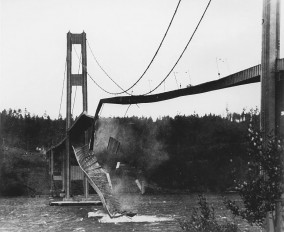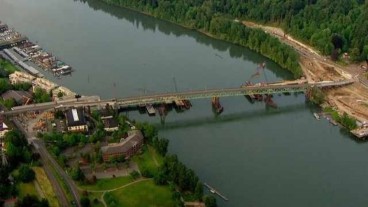New design to make bridge spans longer

Longer bridge spans will be achieved in the future by the utilization of new bridge forms.
Researchers from the University of Sheffield and Brunel University London used a technique that includes mathematical modeling to determine the optimal form of a bridge capable of acquiring long spans. Currently, no bridge span has exceeded 2km in length. Long spans are mostly common in suspension bridges where they are supported by cables linked to the towers.
The problem with bridge spans is that as they become longer, an increasing proportion of their structure strength is needed just to support their own weight. Therefore, after a certain point, a minor augmentation of the span's length will result in a disproportional increase of material needed to carry it, making the design ineffective. The utilization of lighter construction materials is not feasible as steel which is cheap, strong and available in large quantities, remains the most advantageous building component. Thus, the only choice is to alter the bridge's design.
Professor Matthew Gilbert from the University of Sheffield, who led the research, states: "The suspension bridge has been around for hundreds of years and while we've been able to build longer spans through incremental improvements, we've never stopped to look to see if it's actually the best form to use. Our research has shown that more structurally efficient forms do exist, which might open the door to significantly longer bridge spans in the future."
The technique that scientists used was inspired by Davies Gilbert whose mathematical theory claimed that the suspension cables on the Menai Strait Bridge in North Wales followed too shallow a curve. He also presented the optimal shape of a cable in order to carry gravity loads. According to the team's optimum design, towers must be replaced by structures than look like bicycle wheels with multiple spokes. Acknowledging that this design is not practical in a large scale, the team used split towers comprising just two or three ''spokes''. Less material is needed as the forces from the deck are transmitted more efficiently through the bearing structure to the foundations. Load paths are kept short and sharp corners, where stress in concentrated, are avoided.
Researchers focus on the effort to construct an effective bridge span that will connect the Strait of Gibraltar from the Iberian Peninsula to Morocco. The crossing is 14km and it will require a 5km span. A traditional suspension bridge would be too expensive but the proposed ''spoke'' design would require a minor cost increase and would be a feasible design.
Source: Sheffield.ac.uk
Want to read more like this story?

Types of bridges
Jun, 01, 2023 | EducationArch Bridge An arch bridge is a type of bridge that uses a curved, semi-circular structure, kno...

World's most frightening bridges to cross: Part 1
Mar, 20, 2020 | NewsBridges are structures that enable crossings over physical barriers including rivers, valleys and c...

An engineering point of view for the Tacoma Narrows Bridge collapse
Apr, 04, 2023 | EducationIntroduction An iconic civil structure is a bridge. The desire for humans to go from place to...

The most famous bridges of the world
Aug, 26, 2015 | NewsThere are so many bridges in the world in different styles, like old stone bridges or steely, footbr...

Historic Oregon Bridge For Sale
Aug, 15, 2014 | NewsIf anyone is in the market for purchasing an old bridge here is your chance. Multnomah county i...
Bridge Design
Jan, 01, 2019 | EducationBridge design is the process that involves the conceptualization, the strategic planning, and the...

OpenBridge Designer
Aug, 28, 2023 | Software
Italy will construct the world's longest suspension bridge
Mar, 16, 2023 | NewsOn Thursday, March 16, Italy's Council of Ministers authorized the construction of the world's long...

Six Injured in Brent Spence Bridge Crash
Aug, 05, 2014 | NewsSix people were injured this weekend in Cincinnati, Ohio when a car fell off the southbound deck of...
Trending

Spectacular interchanges around the world

New Release - STAAD.Pro 2024 - 2

ADINA 2025 for Structural WorkSuite

ADINA 2025 New Release!

Concrete Buildings as Rechargeable Batteries

Powerful earthquake shakes central Philippines, dozens killed

Indonesia school collapse: three fatalities and dozens injured

